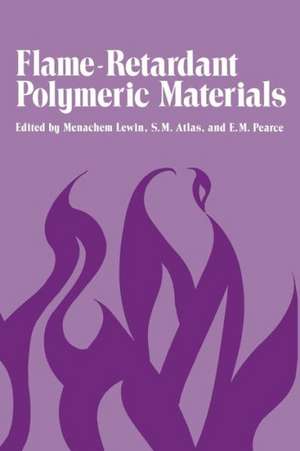Flame-Retardant Polymeric Materials
Editat de Eli Pearceen Limba Engleză Paperback – 14 mai 2013
Preț: 397.01 lei
Nou
Puncte Express: 596
Preț estimativ în valută:
75.97€ • 79.32$ • 62.87£
75.97€ • 79.32$ • 62.87£
Carte tipărită la comandă
Livrare economică 04-18 aprilie
Preluare comenzi: 021 569.72.76
Specificații
ISBN-13: 9781468421507
ISBN-10: 1468421506
Pagini: 472
Ilustrații: XII, 457 p. 14 illus.
Dimensiuni: 152 x 229 x 25 mm
Greutate: 0.63 kg
Ediția:Softcover reprint of the original 1st ed. 1975
Editura: Springer Us
Colecția Springer
Locul publicării:New York, NY, United States
ISBN-10: 1468421506
Pagini: 472
Ilustrații: XII, 457 p. 14 illus.
Dimensiuni: 152 x 229 x 25 mm
Greutate: 0.63 kg
Ediția:Softcover reprint of the original 1st ed. 1975
Editura: Springer Us
Colecția Springer
Locul publicării:New York, NY, United States
Public țintă
ResearchCuprins
1Combustion of Polymers and Its Retardation.- 2 Brief Description of the Phases of Polymer Degradation and Combustion.- 3. Analysis of the Combustion Process and Pertinent Aspects of Flame Retardation.- 4. Semiquantitative Evaluation of Polymer Flammability: The Limiting Oxygen Index (LOI).- 2Technology and Test Methods of Flameproofing of Cellulosics.- 1 Introduction.- 2 Nondurable Flame Retardants.- 3. Semidurable Flame Retardants.- 4 Flame-Resistant Cotton Flote.- 5 Durable Flame Retardants.- 6. Halogens as Flame Retardants.- 7. Flame-Retardant Treatment of Wood, Board, and Paper.- 8. Testing Methods.- 9. References.- 3 Flame Retardance of Protein Fibers.- 1 The Structure of Protein Fibers.- 2 Flammability of Wool.- 3 Mechanism of Thermal Degradation and Combustion.- 4 Smoke Emission and Toxic Fumes.- 5 Mechanism of Flame Retardancy.- 6 Flame-Retardant Treatments.- 7. References.- 4 Flame-Retardant Polyethylene Terephthalate Fibers.- 1 Introduction.- 2 Nonreactive Additives.- 3 Ethylene Terephthalate Copolymers.- 4 Fiber and Fabric Treatments.- 5 Fabric Flammability.- 6 References.- 5 Flame Retardance of Rubbers.- 1 Introduction.- 2 Nature of Burning of Rubber.- 3 Flammability Testing.- 4 Smoke Generation.- 5 Flame Retardancy of Rubbers.- 6 Commercial Rubbers.- 7. Conclusion.- 8. References.- 6 Retardation of Combustion of Polyamides.- 1.Introduction.- 2. Factors Affecting the Combustion and Related Processes of Polyamides.- 3. Thermal and Thermal-Oxidative Degradation of Different Polyamides.- 4. Assessment of Physicochemical Changes in Degrading Polyamides.- 5. Stabilization Against Combustion.- 6. New Trends.- 7. Conclusion.- 8. References.- 7 Relationship Between Chemical Structure and Flammability Resistance of Polyurethanes.- 1 Introduction.- 2 Effect of Structure on Flammability of Urethane Foams.- 2 Modified Urethane Foams.- 4 References.- 8 Retardation of Combustion of Phenolic, Urea-Formaldehyde, Epoxy, and Related Resin Systems.- 1 Introduction.- 2. Phenolic Resins.- 3. Furan Resins.- 4. Urea-Formaldehyde Resins.- 5. Melamine Resins.- 6. Epoxy Resins.- 6.1. Flame Retardation in Epoxy Resins.- 7. Summary.- 8. References.- 9 Candle-Type Test for Flammability of Polymers.- 1. Flammability Measurements.- 2. Critical Oxygen Indexes of Polymers.- 3. A Candle Model of a Burning Polymer.- 4. Polyethylene Burning and a Possible Limitation of the Candle Model.- 5. Modes of Inhibiting the Flammability of Candle-Burning Polymers.- 6. Inhibition by Antimony.- 7. Inhibition by Chlorine.- 8. Inhibition by Dripping.- 9. Inhibition by Fillers.- 10. References.- 10 Flame-Retardant Organic Coatings.- 1 Introduction.- 2 Architectural Coatings.- 3. Fabric Coatings.- 4. Heat-Resistant Organic Coatings.- 5. References.









